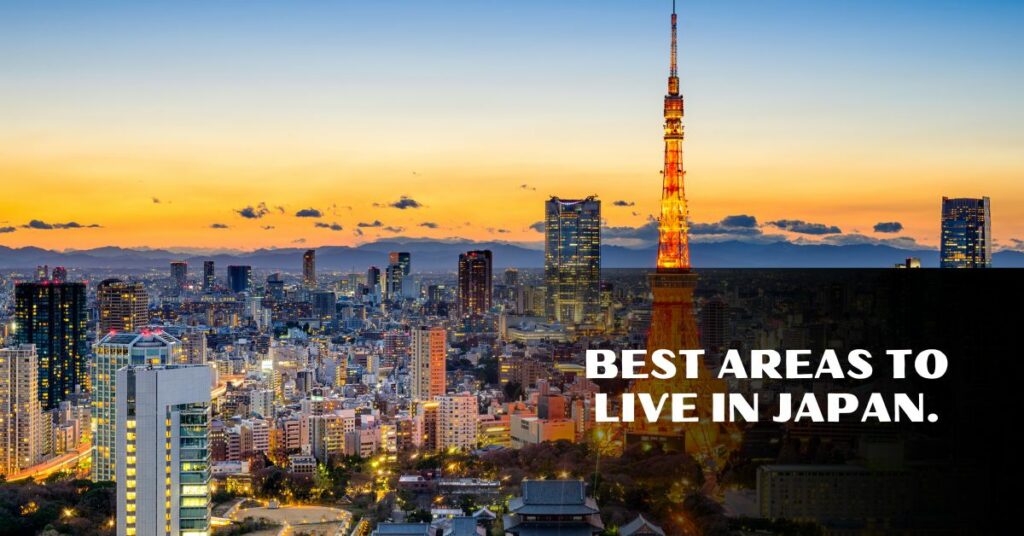When it comes to finding a place to live in Japan, the options can seem overwhelming. From the bustling city life of Tokyo to the tranquil countryside of Miyazaki, there’s a place for every lifestyle and preference. But where are the best areas to live in Japan? Whether you’re considering a move for work or just dreaming of a change of scenery, let’s explore some of the top neighborhoods and towns in Japan that offer the perfect balance of culture, convenience, and quality of life.
1. Tokyo: Japan’s Capital and Financial Center
Tokyo is the capital and cultural, political, and financial center of Japan. With a population of almost 14 million people, it has the highest population density of any city in the country. Many foreign workers come to Japan to work for multinational companies such as Toyota, Mitsubishi, and Honda, with most expats working for international companies living in Central Tokyo, mostly in the areas Minato-ku and Shibuya-ku. These areas are the business centers of Tokyo, with multinational companies having their offices located there. These neighborhoods have international hospitals and shopping centers, restaurants, and other businesses and facilities focused around expats and English-speaking clients. There are also numerous international schools and residential properties built in western style for expat families in these safe and convenient areas. Tokyo offers the perfect mix of high-tech and traditional, making it one of the best places to live in Japan. The city has massive shopping areas that entwine with peaceful residential streets, Japanese gardens, and occasional sightings of Geisha in the park. Overall, Tokyo is a bustling and exciting place to live for both local residents and expats.
2. Nagoya: A Culturally Rich Port City
Nagoya is a culturally rich port city that sits at the heart of Japan. It is known for being a hub of technology and manufacturing, but it also boasts a vibrant cultural scene with numerous museums and historic landmarks. The Nagoya Castle, for example, is a must-visit attraction that dates back to the Edo period and offers stunning views of the skyline. The city is also home to the Toyota Commemorative Museum of Industry and Technology, which provides visitors with a fascinating insight into the history of the famous car manufacturer.
Expats looking to live in Nagoya can take advantage of the city’s excellent transport links, as it is located at the intersection of the Tokaido and Chuo expressways and is serviced by multiple train lines. The cost of living in Nagoya is relatively affordable compared to other metropolitan cities, and expats can enjoy a range of residential options from the bustling central area to the quieter suburbs. There is also a thriving food culture in Nagoya, with signature dishes such as Miso Katsu and Hitsumabushi drawing in visitors from all over Japan.
Overall, Nagoya is an excellent choice for expats looking to experience Japanese culture while also enjoying the convenience and amenities of a modern city. Its rich history and unique local cuisine make it an exciting place to live, and its central location makes it an ideal base for exploring other areas of Japan.
3. Osaka: A Hub of Business and Entertainment
Osaka, the third largest city in Japan, is a hub of business and entertainment. The Kita district, also known as Umeda or North district, is the best area for first-time travelers due to its proximity to JR Osaka station and many tourist attractions. It is a transport hub that connects travelers to other cities in Japan such as Kyoto, Kobe, Nara, and Himeji. The area is filled with skyscrapers, office buildings, shops, restaurants, bars, and big brand department stores. Umeda Station and JR Osaka Station are located right next to each other, and Osaka Station City has rooftop gardens and many shops selling Japanese and international goods. For entertainment, tourists can visit the Umeda Sky Building, the Hep Five Grand Front Osaka Links shopping mall, and the Osaka Museum of Housing and Living. Additionally, Osaka is a good base location for travelers visiting Kansai region. Overall, Osaka is a vibrant and exciting city that offers plenty of opportunities for entertainment, business, and exploration.
4. Yokohama: A Convenient Port City with Beautiful Scenery
Yokohama is a coastal city located just south of Tokyo and is the second largest in Japan. It boasts stunning views of the Pacific Ocean as well as several lush parks, making it a great place for nature lovers. The iconic Yokohama Bay Bridge is also an excellent attraction for tourists and locals alike. The vibrant city is known for its diverse cuisine, particularly its Chinese food, which is said to be some of the best in the world.
Yokohama is known for its international vibe, and it is home to several thriving communities of expats and digital nomads. The city has been ranked as one of the best cities to live in Japan for foreign residents. The living costs are lower than Tokyo, and the transportation system is highly efficient with an extensive subway system and various bus routes. The city also offers excellent job opportunities, with several international companies having their offices located there.
Yokohama has a great mix of urban and suburban living, with its trendy shopping areas, parks, and beautiful beaches perfect for relaxation. There are also several entertainment options, including museums, art galleries, and concerts, making it an ideal city for families as well. Overall, Yokohama is a convenient port city with beautiful scenery that offers a high quality of life for expats and foreigners.
5. Sapporo: A Peaceful City with a Strong Food and Beer Culture
Sapporo, located in the northernmost part of Japan, is known for its snowy winters, but it is also a city with a peaceful and relaxing environment. It is the capital of Hokkaido, Japan’s second-largest island, and boasts a population of approximately 1.9 million people. The city has a strong food culture, especially when it comes to seafood, and is also well-known for its beer, with the Sapporo Beer Museum being a popular tourist destination. Sapporo is home to many parks and gardens, including the picturesque Odori Park, which is a must-see during the Sapporo Snow Festival. The city also has a vibrant nightlife with a wide range of bars and clubs to choose from. Although Sapporo is not as international as Tokyo or Osaka, there are still plenty of opportunities for foreign residents, including teaching jobs and positions in the tourism industry. Sapporo is also considered one of the safest cities in Japan, with a low crime rate and a friendly community. For those looking for a peaceful and relaxing lifestyle, Sapporo may just be the perfect place to call home in Japan.
6. Kyoto: A Historic City Filled with Traditional Japanese Culture
Kyoto is a city full of historical significance and traditional Japanese culture. With 17 UNESCO World Heritage Sites and countless under-the-radar gems, this city is a must-visit for anyone interested in Japan’s rich history. The city is conveniently located with easy access through various modes of transportation, including bullet trains, airport limousines, and taxis. Although Kyoto does not have its own airport, Kansai International Airport and Itami Airport are nearby and provide easy access to the city. Kyoto’s Higashiyama neighborhood is one of the best neighborhoods for immersing oneself in traditional Japanese culture, with its stunning temples and beautiful kimono-clad geisha. Gion, in particular, was once a rambunctious tea-house neighborhood where geisha performed for the ruling classes, and today visitors can enjoy a stroll along ancient lantern-lit walkways or even a traditional tea ceremony. The city is a year-round destination, but spring is particularly unique with the fleeting beauty of cherry blossoms, although it can also be crowded during the Golden Week holiday at the end of April and beginning of May. Despite the seasonal fluctuations, Kyoto is a magical city filled with enchanting history and culture.
7. Fukuoka: A Cosmopolitan City on Japan’s Southern Island
Fukuoka is a city located on Japan’s southern island, Kyushu. It has a population of around 1.5 million residents making it the largest city in the region. Fukuoka is known for its cosmopolitan atmosphere with a blend of local and international cultures. It offers an abundance of job opportunities and a lower cost of living compared to other major cities such as Tokyo or Osaka. Fukuoka provides a balance between modern conveniences and traditional Japanese culture, with ancient temples and shrines scattered throughout the city. In addition to its rich cultural heritage, Fukuoka has an impressive entertainment scene with a vibrant nightlife and various festivals throughout the year. The city is also home to a thriving food culture, with a range of local specialties and international cuisine. Transport is also convenient, with an international airport nearby and easy access to other parts of Japan. Overall, Fukuoka is an attractive option for individuals seeking a balance between work, culture, and leisure in a dynamic and welcoming city.
8. Sendai: A City with Rich History and Natural Beauty
Sendai is a city located in Miyagi prefecture, in the northern region of Japan. It is a city with a rich history and natural beauty, making it a popular destination for travelers. The founder of the city, Lord Date Masamune, played a significant role in its development, leaving behind a legacy that can still be seen today. There are several interesting and beautiful places to see in Sendai, such as the Aoba Castle, Zuihoden Mausoleum, and Rinnoji Temple. The city is also known as the “Forest Capital” due to its abundance of trees and greenery, which can be seen throughout the city and the surrounding areas. The Hirose River flows through the city, and there are several parks and alleys of trees that provide pleasant walking paths. Additionally, Sendai has access to both the ocean and mountains, providing a diverse range of outdoor activities. Access to Sendai is easy with the Tohoku Shinkansen, which takes only 100 minutes from Tokyo. Overall, Sendai is a charming city that offers a unique blend of history and nature.
9. Hiroshima: A City of Resilience with a Vibrant Culture
Hiroshima is a vibrant city in Japan that boasts a complicated history, great food, and friendly locals. Despite being devastated by a nuclear attack at the close of World War II, the city is not morose or bitter about its past but instead promotes peace and understanding. The Peace Memorial Park, with its many monuments commemorating the victims of the atomic bombings, is a must-visit. The Hiroshima Peace Memorial Museum is a confronting yet iconic museum that documents the events of the 1945 atomic bombing of Hiroshima in harrowing detail. Hiroshima is also famous for its robust food culture, with local specialties such as okonomiyaki and oysters. And for baseball fans, the Hiroshima Toyo Carp at Mazda Stadium is a must-see. Getting around the city is easy thanks to the modern tram service called Hiroden. With a population of just over 1.1 million people, the city sprawls out from the bustling city center and is a city of resilience with a vibrant culture.
10. Kobe: A Picturesque City with Delicious Food and Beautiful Scenery
Kobe is a charming city located in the Hyogo prefecture known for its stunning scenery and delicious food. One of the must-see places in Kobe is its lively Chinatown, said to be the largest in Japan. During the Lunar New Year, visitors can witness the vibrant festivities and indulge in some tasty Chinese cuisine. The city also has a romantic atmosphere, highlighted by the Kobe Port area where couples can take a romantic stroll while enjoying the picturesque view of the sunset. The vibrant streets of Kobe are also home to a variety of restaurants serving up sumptuous Kobe beef, one of the most celebrated dishes in Japan. Aside from its gastronomic delights, Kobe has a lot of scenic spots worth exploring such as the Nunobiki Falls and the herb garden on Rokko mountain. Kobe is a city with a rich culture and history, evident in the well-preserved Western-style mansions like the Kitano area. All in all, Kobe is definitely a city worth visiting and exploring, offering a perfect blend of natural beauty, mouth-watering cuisine, and cultural significance.

Meet Michael Graham, the main author of SeekTraveler.com. With a wanderlust that knows no bounds, Michael has traversed more than 30 countries across the globe. From sun-soaked Caribbean islands to the ancient marvels of Europe and the captivating charm of Japan, he has witnessed the wonders of diverse cultures firsthand. Michael’s in-depth knowledge and contagious enthusiasm for travel will inspire you to pack your bags and embark on your own extraordinary journey.



